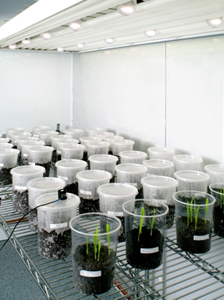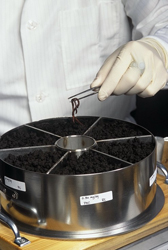Wildlife and landscape science research topics: soil toxicology
| Article Title |
|---|
Soil Toxicology |

Soil toxicology is a branch of environmental toxicology that examines the toxicity of chemical, physical or biological substances to organisms and plants that inhabit the soil.
Absorption, degradation, bioaccumulation, chemical composition, topography, climate, biotic activity, and other variables are all factors that may influence the risks toxic substances pose to biota and environments.
Wildlife and landscape researchers at Environment Canada study the effects of toxic substances on biota and environments in order to assess the risks that pollutants may pose to Canadians and their environment.
The ability to evaluate the risk of a substance to organisms relies on an understanding of their importance to soil habitats, but also good tools with which to assess these risks.
Research is underway to develop, validate, standardize and utilize soil toxicity test methods that provide a balance between chemical and biological measurements. These efforts result in tools that help to better evaluate the realistic risk of individual chemical, physical or biological substances and contaminant mixtures in soils.

Soil toxicity test methods provide tools to support the ability for industry and government to perform realistic site-specific ecological risk assessments, and also serve to assess the effectiveness of remediation programs for the maintenance and sustainability of Canada’s ecozones.
Methods developed by researchers are part of a suite of tools used by governments, industry, private laboratories and others to:
- perform site-specific ecological risk assessments,
- assess the effectiveness of remediation efforts,
- ensure compliance with federal legislation such as the Canadian Environmental Protection Act, 1999 and the Fisheries Act
These methods are developed in partnership with other Environment Canada staff, and regional, provincial and private-sector laboratories. Researchers provide guidance on toxicological data interpretation and program application within Environment Canada and many partner organizations.

- Risk assessment of new (microbial products of biotechnology) substances on Canada's Domestic Substance List by investigating the pathogenic and toxic potential of these substances to terrestrial organisms in soil. This is a collaborative research effort between the Soil Biotechnology Laboratory and the Soil Toxicology Laboratory.
- Evaluation of the bioaccumulation potential of medium priority substances identified through the Government of Canada’s Chemical Management Plan to earthworms in soil, with the provision of this data towards the validation of bioaccumulation models.
- Developing standardized toxicity test methods for Canadian boreal forested regions using ecologically-relevant terrestrial organisms. Read more about boreal soil testing in “Protecting Canada’s Boreal Forests and Northern Ecosystems: Developing Biological Methods to Assess and Preserve Canada’s Soil Environments of the North.”
- Toxic assessments of weathered petroleum hydrocarbon and brine-impacted soils to terrestrial organisms.
- Developing and assessing methods to identify pathogens and track their persistence in the soil environment.

Experts on soil toxicology
Further reading
- Biological Test Method Series: 21 standardized toxicity test methods publications for international laboratory use
- Environment Canada: Pollution and Waste
- The Canadian Environmental Protection Act, 1999 public registry
- Society of Environmental Toxicology and Chemistry (SETAC) Soil Advisory Group (SAG)
- National Water Research Institute’s Research Topics